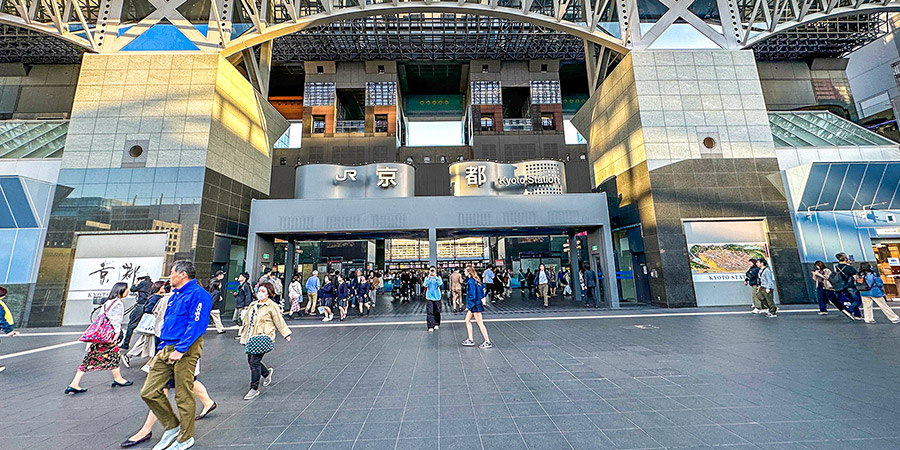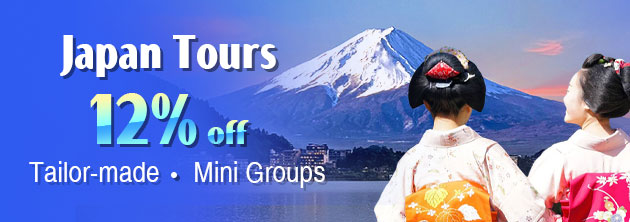Kyoto Transportation
Like situation in Tokyo, the traffic system in Kyoto is also complete: multiple lines of trains and rapid Shinkansen make it easy for visitors from far places to get to Kyoto. Economical buses & subway, along with various transportation cards and passes make travelling in Kyoto more convenient.

Kyoto Station on a clear day and passenger by the entrance
|
Get to Kyoto by Air
There is no airport in Kyoto and the nearest two airports around Kyoto are Kansai International Airport and Osaka International Airport. Both of them are in Osaka. You can first land at either of the two airports and then take trains or buses to get to Kyoto. Kansai International Airport usually serves more international airlines than domestic ones. The Airport connects Japan with other 25 countries in Europe, Asia, Middle East Africa, America, and Oceania. Osaka International Airport usually connects cities in Japan, such as Fukuoka, Osaka, and Sapporo.
Shinkansen (bullet train) to or from Kyoto
Tokaido Shinkansen is the only bullet train line passing by Kyoto, traveling west to Shin-Osaka and east to Tokyo. In addition, there are 14 stations between Kyoto and Tokyo and the train will pass by Nagoya, Odawara, Shinyokohama, and so on.

A Shinkansen train is running by the platform
|
Below chart shows time and prices needed between Kyoto Station and other stations by Shinkansen.
| Station | Least Time | Lowest Price |
| Shin-Osaka Station | 13 minutes | 1,450 yen |
| Tokyo Station | 2 h 12 minutes | 13,320 yen |
| Nagoya Station | 34 minutes | 5,170 yen |
| Shin-Yokohama Station | 1 h 53 minutes | 13,700 yen |
To get to more cities in the west of Kyoto by Shinkansen, such as Hiroshima, Okayama, and Hakata, you need to take Tokaido Shinkansen to Shin-Osaka Station first, and then transfer to Sanyo Shinkansen.
Read More:
Trains to or from Kyoto
Apart from Shinkansen, ordinary trains operated by JR and private companies are another quick way to connect Kyoto and other major cities in Japan. For visitors from cities far away like Tokyo, Nagoya, and Yokohama, transferring trains several times is very common and time needed is longer, compared with taking Shinkansen. Still, the ticket price is much lower.
|
|
|
This chart shows the least time and lowest price for traveling between Kyoto Station and other stations by ordinary train.
| Destination | Least Time | Lowest Price |
| Shin-Osaka Station | 23 minutes | 580 yen |
| Tokyo Station | 6 h 51 minutes | 8,500 yen |
| Nagoya Station | 2 h 28 minutes | 2,640 yen |
| Shin-Yokohama Station | more than 8 hours | more than 8,000 yen |
Kyoto Subway
There are only 2 subway lines in Kyoto: Karasuama Line and Tozai Line. Except for Takeda station of Karasuma Line, all other stations are built underground. You can transfer between the 2 lines at Karasuma Oike station.Service time: 5 a.m. – 24:00 a.m.
Ticket fare: 220-350 yen
Frequency: 5-8 minutes on average; 10 minutes before 7 a.m. and after 9 p.m.
|
|
|
Read more:

The passengers are waiting by the Kyoto bus stop
|
Kyoto Bus
In Kyoto, visiting various tourist attractions by bus is more convenient than other transportation tools. There are 2 kinds of buses: one runs along the fixed routes every day; the other is designed for sightseeing and mainly operates on weekends and holidays. Kyoto’s most tourist attractions are covered by these 2 kinds of buses. Buses for sightseeing, especially Sky Hop Bus, would only stop by major attractions, thus time-saving for visitors.
1. Bus running on fixed-route
|
|
Kyoto City Bus | Kyoto Bus | Keihan Bus | JR Bus |
| Identification colors | Green | Brown | Red | Blue |
| Daily operation hours | 6 a.m. - 10 p.m. | |||
| Price |
230 yen per ride within the flat-fare zone Additional fees are needed outside the zone |
|||
| Covering areas | entire Kyoto |
Kurama, Kifune, and Ohara |
Yamashina | northwest of Kyoto Station |
| Frequency | 20 minutes | 25 minutes | 20 - 45 minutes | 30 minutes |
2. Bus for sightseeing
|
|
Sky Hop Bus | Rokuroku Line Buses |
| Service time |
Every day: 8:40 a.m. – 5 p.m. |
On weekends and holidays: 9 a.m. – 4:40 p.m. |
| Price |
4,000 yen a day and 6,000 yen for 2 days |
500 yen per ride for lines 100 and 101; 230 yen for 102 and 105 per ride within flat-fare zone, and additional fees is charged outside the zone |
| Frequency |
16 buses a day |
15 – 30 minutes |
| Part of passing-by tourist attractions and important stations |
Kyoto Station, Nishihongan-ji Temple, Shijo
Karasuma, Nijo Castle, Kitano Tenmangu Shrinn, Kinkakji Temple, Daitokuji
Temple, Kyoto Imperial Palace, Nishiki Market, and so on. |
|
Read more:
Taxi
In Kyoto, it is easier to hail a taxi near bus stops, before hotels, and by the trunk road. Some drivers can speak some basic English, which avoids the language barrier.
|
|
|
Acceptable payment methods are cash, credit card, and common electronic payment modes in Japan include Apple Pay, PayPay, and Line Pay. Note that PayPay and Line Pay accounts could be registered with Japanese numbers.
Transportation Card and Passes
Buying a transportation IC card or pass is very economical and it will save you much time.
ICOCA or Kansai One Pass – the stored value card, is the most useful transportation IC card in Kyoto. With it, you can take most public vehicles while traveling, including bus, subway, and train. Also, such cards can be used to make payments in many convenience stores, restaurants, and coffee shops.

